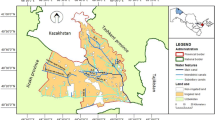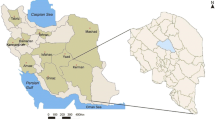Abstract
Irrigation water salinity is one of the factors that reduces agricultural production. Guilan Province is one of the most important rice-producing areas in Iran where groundwater is used for irrigation. The temporal and spatial variations of groundwater salinity were studied in the coastal strip covering 4285 km2 of the province using data from 73 wells, as well as its estimated effect on the rice yield. Data on mean electrical conductivity (EC) for each 6-month period of 12 consecutive years, from the second half of 2002 until the end of 2014, were analyzed and resulted in 25 mean ECs. EC maps and maps of the probability of higher salinity areas were obtained by using ordinary kriging (OK) and indicator kriging (IK) in ArcGIS 9.3 software, respectively. Thereby, areas belonging to different salinity classes were outlined and places with higher salinity reducing the rice yield were identified. In addition, the Mann–Kendall test and Sen’s slope were used to project future changes. The results indicated that due to the salinity of groundwater in the coastal strip area, the minimum and the maximum rice yields were 80% and 100%, respectively. Using the IK method, higher probability of groundwater salinity reducing the yield was found from the central parts toward the east. The Mann–Kendal test result showed significant temporal trends of the size of areas below the 100% yield (EC < 1 dS/m) and 90–100% yield (1 < EC < 1.34 dS/m) thresholds. The equations given by Sen’s slope estimator indicated that the groundwater salinity will not be a limiting factor for achieving 100% rice yields from the year of 2021 onward in all of the Guilan coastal area. The trend of increasing precipitation in the area may be an important cause.






Similar content being viewed by others
References
Abbasi, F., Babaian, I., Malboosi, S., Asmari, M., & Mokhtari, L. G. (2012). Climate change assessment over Iran during future decades, using statistical downscaling of ECHO-G model. Geographical Research, 27(1(104)), 205–230 (in Persian).
Ahmadpour, H., Khaledian, M. R., & Ashrafzadeh, A. (2015). Examine the relationship between groundwater salinity with Sefidrud River and the Caspian Sea. In Third International Symposium on Environment and Water Resources Engineering. 2–3 June. Tehran, Iran.
Arslan, H. (2012). Spatial and temporal mapping of groundwater salinity using ordinary kriging and indicator kriging: the case of Bafra plain, Turkey. Agricultural Water Management, 113, 57–63. https://doi.org/10.1016/j.agwat.2012.06.015.
Ashrafzadeh, A., Roshandel, F., Khaledian, M., Vazifedoust, M., & Rezaei, M. (2016). Assessment of groundwater salinity risk using kriging methods: a case study in northern Iran. Agricultural Water Management, 178, 215–224. https://doi.org/10.1016/j.agwat.2016.09.028.
Ashrafzadeh, A., Malik, A., Jothiprakash, V., Ghorbani, M. A., & Biazar, S. M. (2018). Estimation of daily pan evaporation using neural networks and meta-heuristic approaches. ISH Journal of Hydraulic Engineering, 1–9. https://doi.org/10.1080/09715010.2018.1498754.
Baillie, I. C. (2001). Soil survey staff 1999, soil taxonomy: a basic system of soil classification for making and interpreting soil surveys, agricultural handbook 436, Natural Resources Conservation Service, USDA, Washington DC, USA, pp. 869. Soil Use and Management, 17(1), 57–60.
Belkhiri, L., Mouni, L., Sheikhy Narany, T., & Tiri, A. (2017). Evaluation of potential health risk of heavy metals in groundwater using the integration of indicator kriging and multivariate statistical methods. Groundwater for Sustainable Development, 4, 12–22. https://doi.org/10.1016/j.gsd.2016.10.003.
Bouman, B. A. M., Barker, R., Humphreys, E., Tuong, T. P., Atlin, G., Bennett, J., & Facon, T. (2007). Rice: feeding the billions. IWMI.
Cambardella, C. A., Moorman, T. B., Parkin, T. B., Karlen, D. L., Novak, J. M., Turco, R. F., & Konopka, A. E. (1994). Field-scale variability of soil properties in Central Iowa soils. Soil Science Society of America Journal, 58(5), 1501. https://doi.org/10.2136/sssaj1994.03615995005800050033x.
Chandrasekharan, H., Sarangi, A., Nagarajan, M., Singh, V. P., Rao, D. U. M., Stalin, P., & Anbazhagan, S. (2008). Variability of soil–water quality due to Tsunami-2004 in the coastal belt of Nagapattinam District, Tamilnadu. Journal of Environmental Management, 89(1), 63–72.
Chica-Olmo, M., Luque-Espinar, J. A., Rodriguez-Galiano, V., Pardo-Igúzquiza, E., & Chica-Rivas, L. (2014). Categorical indicator kriging for assessing the risk of groundwater nitrate pollution: the case of Vega de Granada aquifer (SE Spain). Science of the Total Environment, 470–471, 229–239. https://doi.org/10.1016/j.scitotenv.2013.09.077.
Cox, J. W., & McFarlane, D. J. (1995). The causes of waterlogging in shallow soils and their drainage in southwestern Australia. Journal of Hydrology, 167(1), 175–194. https://doi.org/10.1016/0022-1694(94)02614-H.
Dash, J. P., Sarangi, A., & Singh, D. K. (2010). Spatial variability of groundwater depth and quality parameters in the National Capital Territory of Delhi. Environmental Management, 45(3), 640–650. https://doi.org/10.1007/s00267-010-9436-z.
Delbari, M., & Afrasiab, P. (2014). Application of indicator and ordinary kringing for modeling of groundwater chloride. Journal of Environmental Studies, 40(3(71)), 751–764 (in Persian). Retrieved from http://en.journals.sid.ir/ViewPaper.aspx?ID=455421.
Delbari, M., Amiri, M., & Motlagh, M. B. (2016). Assessing groundwater quality for irrigation using indicator kriging method. Applied Water Science, 6(4), 371–381. https://doi.org/10.1007/s13201-014-0230-6.
Delgado, C., Pacheco, J., Cabrera, A., Batllori, E., Orellana, R., & Bautista, F. (2010). Quality of groundwater for irrigation in tropical karst environment: the case of Yucatán, Mexico. Agricultural Water Management, 97(10), 1423–1433. https://doi.org/10.1016/j.agwat.2010.04.006.
Döll, P., & Flörke, M. (2005). Global-scale estimation of diffuse groundwater recharge: model tuning to local data for semi-arid and arid regions and assessment of climate change impact.
Emery, X. (2006). Ordinary multigaussian kriging for mapping conditional probabilities of soil properties. Geoderma, 132(1–2), 75–88.
Farid, I., Zouari, K., Trabelsi, R., & Kallali, A. R. (2014). Application of environmental tracers to study groundwater recharge in a semi-arid area of Central Tunisia. Hydrological Sciences Journal, 59(11), 2072–2085.
Flipo, N., Jeannée, N., Poulin, M., Even, S., & Ledoux, E. (2007). Assessment of nitrate pollution in the Grand Morin aquifers (France): combined use of geostatistics and physically based modeling. Environmental Pollution, 146(1), 241–256. https://doi.org/10.1016/j.envpol.2006.03.056.
Gholami, V., Chau, K. W., Fadaee, F., Torkaman, J., & Ghaffari, A. (2015). Modeling of groundwater level fluctuations using dendrochronology in alluvial aquifers. Journal of Hydrology, 529, 1060–1069.
Goovaerts, P., Webster, R., & Dubois, J.-P. (1997). Assessing the risk of soil contamination in the Swiss Jura using indicator geostatistics. Environmental and Ecological Statistics, 4(1), 49–64. https://doi.org/10.1023/A:1018505924603.
Guilan Irrigation and Drainage Network Exploitation Firm. (2011). Annual performance report. Rasht, Iran.
Hadizadeh, F., Allahyari, M. S., Damalas, C. A., & Yazdani, M. R. (2018). Integrated management of agricultural water resources among paddy farmers in northern Iran. Agricultural Water Management, 200, 19–26.
I.R. Of Iran Meteorological Organization. (2018). Retrieved from http://gilmet.ir/.
Johnston, K., Ver Hoef, J. M., Krivoruchko, K., & Lucas, N. (2001). Using ArcGIS geostatistical analyst (p. 300).
Journel, A. G., & Huijbregts, C. J. (1978). Mining geostatistics. London - New York: San Francisco Academic Press.
Karandish, F., & Shahnazari, A. (2014). Appraisal of the geostatistical methods to estimate Mazandaran coastal ground water quality. Caspian Journal of Environmental Sciences. Retrieved from http://research.guilan.ac.ir/cjes/.papers/31612%2D%2D%2D%2D%2D%2D%2D%2D%2D%2D%2D%2D013%2D%2D53-7.pdf.
Kendall, G. M. (1975). Rank Correlation Methods (griffin). London, UK.
Lee, J.-J., Jang, C.-S., Wang, S.-W., & Liu, C.-W. (2007). Evaluation of potential health risk of arsenic-affected groundwater using indicator kriging and dose response model. Science of the Total Environment, 384(1–3), 151–162. https://doi.org/10.1016/j.scitotenv.2007.06.021.
Maclean, J. L., Dawe, D. C., Hardy, B., & Hettel, G. P. (2002). Rice almanac, 3rd edn. International Rice Research Institute. CABI Publishing, Oxford Google Scholar.
Mann, H. B. (1945). Nonparametric tests against trend. Econometrica, 13(3), 245. https://doi.org/10.2307/1907187.
McFarlane, D. J., & Williamson, D. R. (2002). An overview of water logging and salinity in southwestern Australia as related to the ‘Ucarro’ experimental catchment. Agricultural Water Management, 53(1–3), 5–29. https://doi.org/10.1016/S0378-3774(01)00153-6.
Mejri, S., Chekirbene, A., Tsujimura, M., Boughdiri, M., & Mlayah, A. (2018). Tracing groundwater salinization processes in an inland aquifer: a hydrogeochemical and isotopic approach in Sminja aquifer (Zaghouan, northeast of Tunisia). Journal of African Earth Sciences, 147, 511–522.
Mishra, U., Lal, R., Slater, B., Calhoun, F., Liu, D., & Van Meirvenne, M. (2009). Predicting soil organic carbon stock using profile depth distribution functions and ordinary kriging. Soil Science Society of America Journal, 73(2), 614–621.
Moore, G. A., & McFarlane, D. (2001). Waterlogging. In Soilguide (soil guide): a handbook for understanding and managing agricultural soils (pp. 94–108). Perth, WA: Department of Agriculture and Food, WA Retrieved from http://researchlibrary.agric.wa.gov.au/cgi/viewcontent.cgi?article=1001&context=bulletins.
Nematollahi, M. J., Clark, M. J. R., Ebrahimi, P., & Ebrahimi, M. (2018). Preliminary assessment of groundwater hydrogeochemistry within Gilan, a northern province of Iran. Enviromental Monitoring and Assessement, 190(242), 1–23. https://doi.org/10.1007/s10661-018-6543-4.
Niajalili, M., Mayeli, P., Naghashzadegan, M., & Poshtiri, A. H. (2017). Techno-economic feasibility of off-grid solar irrigation for a rice paddy in Guilan Province in Iran: a case study. Solar Energy, 150, 546–557.
Pars Ab Tadbir Consulting, N. E. S. P. (Pvt) L. (2005). Northern cities water supply and sanitation project: environmental assessment (Vol. 3): Environmental assessment - Rasht and Anzali (English). Iran. Retrieved from http://documents.worldbank.org/curated/en/758121468044098835/Environmental-assessment-Rasht-and-Anzali.
Piccini, C., Marchetti, A., Farina, R., & Francaviglia, R. (2012). Application of indicator kriging to evaluate the probability of exceeding nitrate contamination thresholds. International Journal of Environmental Research, 6(4), 853–862 Retrieved from https://ijer.ut.ac.ir/article_556_92327bce4dedfc68f028bac9cb811102.pdf.
Pirmoradian, N., Rezaei, M., Davatgar, N., Tajdari, K., & Abolpour, B. (2010). Comparing of interpolation methods in rice cultivation vulnerability mapping due to groundwater quality in Guilan, north of Iran. In 2010 International Conference on Environmental Engineering and Applications (pp. 147–150). IEEE.
Rahnamiy, T. (2001). Gilan agriculture. In E. Eslah arabani (Ed.), Gilan Book (pp. 111–124). Iran Researchers Group. (in persian)
Rezaei, M., Davatgar, N., Tajdari, K. H., & Aboulpour, B. (2010). Investigation the spatial variability of some important groundwater quality factors in Guilan, Iran. Journal of Water and Soil, 24(5), 32–41.
Rezaei, M., Davatgar, N., Khaledian, M. R., & Pirmoradian, N. (2013). Effect of intermittent irrigation with saline water on rice yield in Rasht, Iran. Acta Agriculturae Slovenica. Versita.
Sahasrabuddhe, K., Mahabaleshwarkar, M., Joshi, J., Kanade, R., Goturkar, S., Oswal, P., & Patwardhan, A. (2003). Changing status of urban water bodies and associated health concerns in Pune, India. In International Conference on Environment and Health Chennai.
Sen, P. K. (1968). Estimates of the regression coefficient based on Kendall’s tau. Journal of the American Statistical Association, 63(324), 1379. https://doi.org/10.2307/2285891.
Seyedmohammadi, J., Esmaeelnejad, L., & Shabanpour, M. (2016). Spatial variation modelling of groundwater electrical conductivity using geostatistics and GIS. Modeling Earth Systems and Environment, 2(4), 1–10. https://doi.org/10.1007/s40808-016-0226-3.
Solaimanisardo, M., Vali, A. A., Ghazavi, R., & Saidi Goraghani, H. R. (2013). Trend analysis of chemical water quality parameters; case study Cham Anjir river. Iranian of Irrigation and Water Engineering, 3(12), 95–106 (in Persian).
Statistical Center of Iran. (2011). Selected findings of the 2011 national population and housing census. Retrieved from www.amar.org.irde
Statistics, A. A. (2011). Ministry of Jihad-e-Agriculture of Iran.
Theil, H. (1992). A rank-invariant method of linear and polynomial regression analysis. In B. Raj & J. Koerts (Eds.), Henri Theil’s contributions to economics and econometrics: econometric theory and methodology (pp. 345–381). Dordrecht: Springer Netherlands. https://doi.org/10.1007/978-94-011-2546-8_20.
Yang, F., Cao, S., Liu, X., & Yang, K. (2008). Design of groundwater level monitoring network with ordinary kriging. Journal of Hydrodynamics, 20(3), 339–346.
Yasrebi, J., Saffari, M., Fathi, H., Karimian, N., Moazallahi, M., & Gazni, R. (2009). Evaluation and comparison of ordinary kriging and inverse distance weighting methods for prediction of spatial variability of some soil chemical parameters. Research Journal of Biological Sciences, 4(1), 93–102.
Yidana, S. M., Banoeng-Yakubo, B., & Akabzaa, T. M. (2010). Analysis of groundwater quality using multivariate and spatial analyses in the Keta basin, Ghana. Journal of African Earth Sciences, 58(2), 220–234. https://doi.org/10.1016/j.jafrearsci.2010.03.003.
Yimit, H., Eziz, M., Mamat, M., & Tohti, G. (2011). Variations in groundwater levels and salinity in the Ili River Irrigation Area, Xinjiang, Northwest China: a geostatistical approach. International Journal of Sustainable Development & World Ecology, 18(1), 55–64. https://doi.org/10.1080/13504509.2011.544871.
Author information
Authors and Affiliations
Corresponding author
Additional information
Publisher’s note
Springer Nature remains neutral with regard to jurisdictional claims in published maps and institutional affiliations.
Rights and permissions
About this article
Cite this article
Pouryazdankhah, H., Shahnazari, A., Ahmadi, M.Z. et al. Rice yield estimation based on forecasting the future condition of groundwater salinity in the Caspian coastal strip of Guilan Province, Iran. Environ Monit Assess 191, 492 (2019). https://doi.org/10.1007/s10661-019-7613-y
Received:
Accepted:
Published:
DOI: https://doi.org/10.1007/s10661-019-7613-y




